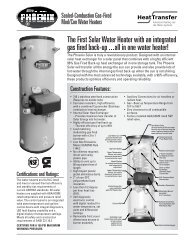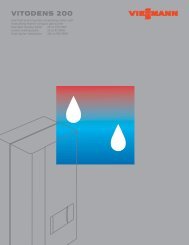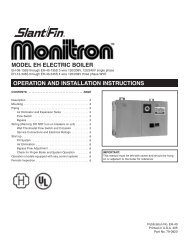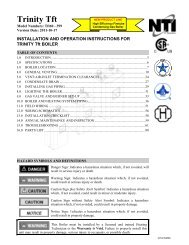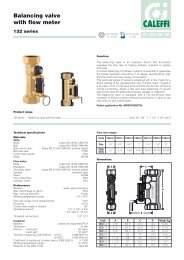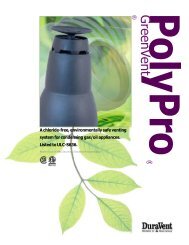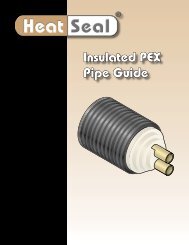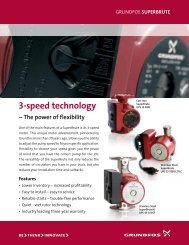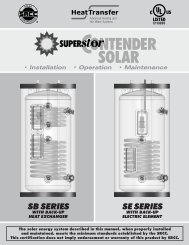Apricus Solar Water Heating System Installation and Operation ...
Apricus Solar Water Heating System Installation and Operation ...
Apricus Solar Water Heating System Installation and Operation ...
Create successful ePaper yourself
Turn your PDF publications into a flip-book with our unique Google optimized e-Paper software.
<strong>Apricus</strong> <strong>Solar</strong> Collector <strong>Installation</strong> & <strong>Operation</strong> Manual - USA6.3.3. Temperature Sensor <strong>Installation</strong> - Tanka) <strong>Solar</strong> Ready Tanks: Some tanks on the market may have sensor ports incorporated into the tank.These ports may or may not be in the best location for the system configuration being used. If they are,then coat the sensors with a thin layer of heat transfer paste <strong>and</strong> insert full depth. Secure the cables inplace to prevent them from losing contact over time. It is vital that accurate readings of the tank temperatureare taken.b) Custom Sensor Port Location: In many cases, the tanks may NOT have a sensor port in a suitablelocation. This is often the case when positioning the mid tank sensor (T3), which may need to have an adhoc sensor port created in order to provide the required hot water “buffer” volume. Usually, T3 is locatedbetween 1/4 <strong>and</strong> halfway down from the top of the tank, depending on desired amount of buffer.At present, there is no consensus on an industry st<strong>and</strong>ard method for making sensor contact with the tank.The following is the method recommended by <strong>Apricus</strong>. It may , however, VOID the warranty of the tank:Step 1. Determine the sensor location. This based upon the specific function thesensor is being used to control <strong>and</strong> the tank design. Keep in mind that most storagetanks have AT LEAST 4” of insulation between the top of the heater casing <strong>and</strong> theactual water jacket. If the system design calls for T3 to monitor a specific volume, youwill need to get determine the dimensions of the actual water tank <strong>and</strong> how itcorresponds to the outer shell. For example, if you want the sensor exactly in themiddle of the tank <strong>and</strong> you simply measure outside of the tank, then your sensor will belocated a good 4” or more ABOVE the mid-level mark of the water inside.Step 2. Make a 1” hole in the tank casing using a step/taper drill bit (see image toright). Ensure the drill bit is NOT long enough to make contact with the inner tank wall,normally 2” in from the casing. Any contact with the tank wall could void the warranty,<strong>and</strong> pose a danger of a tank leakage.Step 3. Use a screwdriver to clean out the insulation in the hole <strong>and</strong> make contact with the inner tankwall.Step 4. Use a piece of copper pipe with the last 1-#” bent 90° to make a downward hole for the sensorto sit in. Ensure there is clean metal for the sensor to contact. Many tanks have a plastic sheetbetween the tank wall <strong>and</strong> the insulation; make sure you scrape through this to the metal.Step 5. Coat the sensor with a generous layer of thermal paste <strong>and</strong> it push down into the hole.Step 6. Pack the hole with glass or rock wool insulation to ensure there is no heat loss from the hole<strong>and</strong> the sensor is secured firmly in place. Do not use polyurethane spray foam, because it will pushthe sensor out of place <strong>and</strong> is difficult to remove should the sensor need to be replaced.Step 7. Use a piece of sheet metal to cover the hole. Make sure to protect the sensor wire <strong>and</strong> that itcan be held in place. Use 3-4 short, self tapping screws to attach the plate to the tank casing. Takecare not to cut or stress the wire. Ensure the finish is clean <strong>and</strong> does not have any sharp edges orburs.Step 7. Run the wire to the pump station <strong>and</strong> secure the wire in place against the outer case of thetank with cable ties along the outside of the pipe insulation to the pump station (as appropriate).WARNINGIf drilling a hole in the tank casing to fit the sensor, take EXTREME care not to contact theinner tank wall with the drill bit. Contacting the inner wall could void the warranty of thetank <strong>and</strong> cause damage resulting in premature tank leaks/rupture, which could lead towater damage to the surrounding building. Contact the tank manufacturer to determine ifthe above procedure will void the warranty BEFORE modifying the storage tank.Copyright 2011 – <strong>Apricus</strong> Inc Doc: A7-05.4.1.4-PB-1.9 Page 55 of 126



